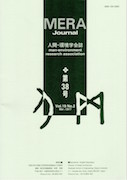Volume 1, Issue 1
Displaying 1-14 of 14 articles from this issue
- |<
- <
- 1
- >
- >|
-
Article type: Cover
1992 Volume 1 Issue 1 Pages Cover1-
Published: November 14, 1992
Released on J-STAGE: December 01, 2017
Download PDF (19K) -
Article type: Index
1992 Volume 1 Issue 1 Pages Toc1-
Published: November 14, 1992
Released on J-STAGE: December 01, 2017
Download PDF (29K) -
Article type: Bibliography
1992 Volume 1 Issue 1 Pages Misc1-
Published: November 14, 1992
Released on J-STAGE: December 01, 2017
Download PDF (21K) -
Article type: Article
1992 Volume 1 Issue 1 Pages 1-
Published: November 14, 1992
Released on J-STAGE: December 01, 2017
Download PDF (198K) -
Article type: Article
1992 Volume 1 Issue 1 Pages 2-5
Published: November 14, 1992
Released on J-STAGE: December 01, 2017
Download PDF (555K) -
Article type: Article
1992 Volume 1 Issue 1 Pages 6-12
Published: November 14, 1992
Released on J-STAGE: December 01, 2017
Download PDF (869K) -
Article type: Article
1992 Volume 1 Issue 1 Pages 13-19
Published: November 14, 1992
Released on J-STAGE: December 01, 2017
Download PDF (845K) -
Article type: Article
1992 Volume 1 Issue 1 Pages 20-28
Published: November 14, 1992
Released on J-STAGE: December 01, 2017
Download PDF (1229K) -
Article type: Article
1992 Volume 1 Issue 1 Pages 29-36
Published: November 14, 1992
Released on J-STAGE: December 01, 2017
Download PDF (733K) -
Article type: Article
1992 Volume 1 Issue 1 Pages 37-39
Published: November 14, 1992
Released on J-STAGE: December 01, 2017
Download PDF (440K) -
Article type: Article
1992 Volume 1 Issue 1 Pages 40-
Published: November 14, 1992
Released on J-STAGE: December 01, 2017
Download PDF (204K) -
Article type: Article
1992 Volume 1 Issue 1 Pages 41-
Published: November 14, 1992
Released on J-STAGE: December 01, 2017
Download PDF (215K) -
Article type: Appendix
1992 Volume 1 Issue 1 Pages App1-
Published: November 14, 1992
Released on J-STAGE: December 01, 2017
Download PDF (18K) -
Article type: Cover
1992 Volume 1 Issue 1 Pages Cover2-
Published: November 14, 1992
Released on J-STAGE: December 01, 2017
Download PDF (27K)
- |<
- <
- 1
- >
- >|
